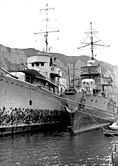User:Allard
Hello and a warm welcome to all my fellow Wikipedians. How nice of you to drop in to see who I am!
Morning>
Wikipedia & me:
[edit]How I discovered Wikipedia, I do not remember. But from being a reader I slowly became a contributor. Although I don't work that much on Wikipedia I do see myself as a Wikipedian. I don't go searching on Wikipedia what I can edit next, I edit what I find and want to do. This means I add and mainly improve a lot of small things and only rarely I make large edits.
My work:
[edit]Articles I've started on Wikipedia:
- Fort Knox Bullion Depository
- Animals are Beautiful People
- Template:David Attenborough Television Series
- Template:Malta Islands
Images I made for Wikipedia:
 Dutch lower house as from 2006
Dutch lower house as from 2006 New image of the Netherlands Air Force Roundel
New image of the Netherlands Air Force RoundelMap on membership of the League of Nations
United Nations membership map
 Improved image of the British Helgoland flag
Improved image of the British Helgoland flag New image showing the current flag of Hel(i)goland
New image showing the current flag of Hel(i)goland
Article guide:
[edit]A list of articles worth looking at, if one can find them:
- Antidisestablishmentarianism
- Ball's Pyramid
- British Isles (terminology)
- Eadweard Muybridge
- Gunpowder Plot
- Horace de Vere Cole
- Humphrey (cat)
- Islomania
- List of countries by date of nationhood
- List of flags
- List of people who died on their birthdays
- List of regnal numerals of future British monarchs
- List of unusual deaths
- Northwest Angle
- Quadripoint
- Racetrack Playa
- Rule of tincture
- San Gimignano
- Transcontinental country
- Undivided India & Partition of India
- Voyager Golden Record
- Web colors
- Winchester Mystery House
And there's always the Random article
And to all citizens of the European Union, please read this: Oneseat.eu
News
[edit]- Maia Sandu (pictured) is re-elected President of Moldova.
- In baseball, the Yokohama DeNA BayStars defeat the Fukuoka SoftBank Hawks to win the Japan Series.
- A canopy collapse at Serbia's Novi Sad railway station kills fourteen people.
- The ruins of a Maya city, dubbed Valeriana, are discovered in Campeche, Mexico.
Selected anniversaries
[edit]November 6: Gustavus Adolphus Day in Estonia, Finland and Sweden
- 1217 – King Henry III of England issued the Charter of the Forest, re-establishing the rights of access of free men to royal forests.
- 1794 – French Revolutionary Wars: Two British ships were intercepted by a French squadron, leading to the French seizure of the HMS Alexander.
- 1868 – Red Cloud (pictured), a Native American leader of the Oglala Lakota tribe, signed the Treaty of Fort Laramie, ending Red Cloud's War and establishing the Great Sioux Reservation.
- 1917 – First World War: Canadian forces captured Passendale, Belgium, after three months of fighting against the Germans at the Battle of Passchendaele.
- 1988 – Two earthquakes occurring 12 minutes apart struck Yunnan near the China–Myanmar border, killing more than 730 people.
- Nasta Rojc (b. 1883)
- Jerry Yang (b. 1968)
- Emma Stone (b. 1988)
- Anthony Sawoniuk (d. 2005)
Did you know...
[edit]- ... that the name of the Japanese band Sajou no Hana (vocalist pictured) has no official meaning?
- ... that From Warsaw to Ojców, an 1897 Polish adventure and travel novel for young readers, was inspired by Jules Verne's works but reflects Polish patriotic and educational values?
- ... that a portrait engraver made the controversial decision to change a Sioux chief's war bonnet so that it would fit on the 1899 United States five-dollar silver certificate?
- ... that Charli XCX once followed George Daniel into a toilet but stopped halfway, and later wrote the song "Talk Talk" about the experience?
- ... that Rose O'Neill's marriage to Hugh Roe O'Donnell united two powerful noble families that had been rivals for centuries?
- ... that the practice of some Christians of making the lesser sign of the cross has been traced back to the 11th century?
- ... that Frederick Prigg and his predecessor as secretary of the Provisional Government of Oregon were both doctors who drowned in a river at Oregon City just three years apart?
- ... that a rainbow plaque marks the site of Peckham's Black Lesbian and Gay Centre?
- ... that one of the paintings sold by Beijing Hanhai was stolen by an emperor, and another was hidden in a well?
Today's featured article
[edit]Ljubljana was the third and last Beograd-class destroyer built for the Royal Yugoslav Navy in the late 1930s. She was designed to operate as part of a division led by Dubrovnik, the flotilla leader. Ljubljana entered service in November 1939, was armed with a main battery of four Škoda 120 mm (4.7 in) guns in single mounts, and had a top speed of 35 knots (65 km/h; 40 mph). In 1940, Ljubljana ran aground on a reef off the Yugoslav port of Šibenik, where, badly damaged, she was taken for repairs. Yugoslavia entered World War II when the Axis powers led by Germany invaded in April 1941, and Ljubljana—still under repair—was captured by the Royal Italian Navy. After repairs were completed, she saw active service in the Royal Italian Navy under the name Lubiana, mainly as a convoy escort on routes between Italy and North Africa. She was lost on 1 April 1943, when she ran aground and was abandoned off the Tunisian coast. (This article is part of a featured topic: Ships of the Royal Yugoslav Navy.)











